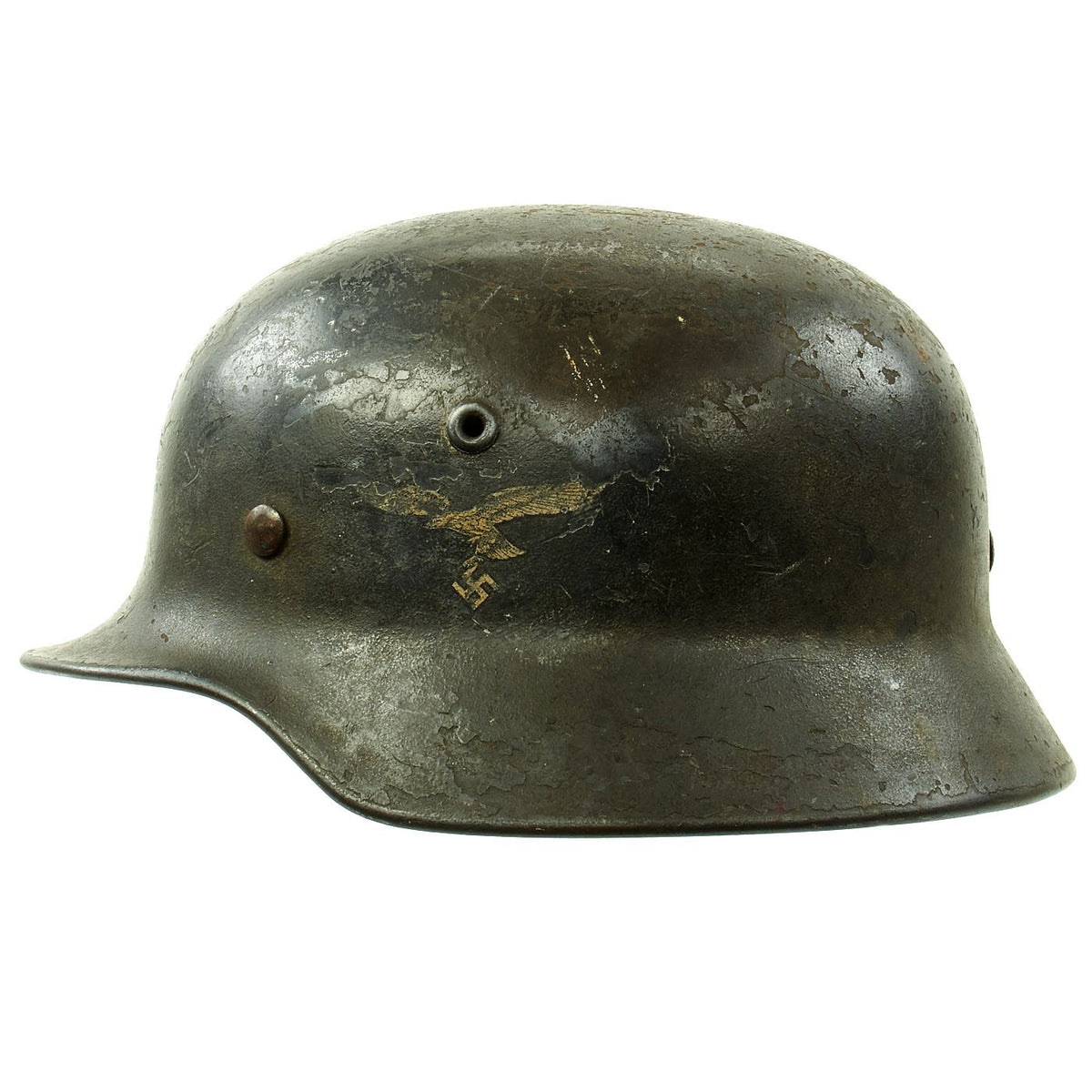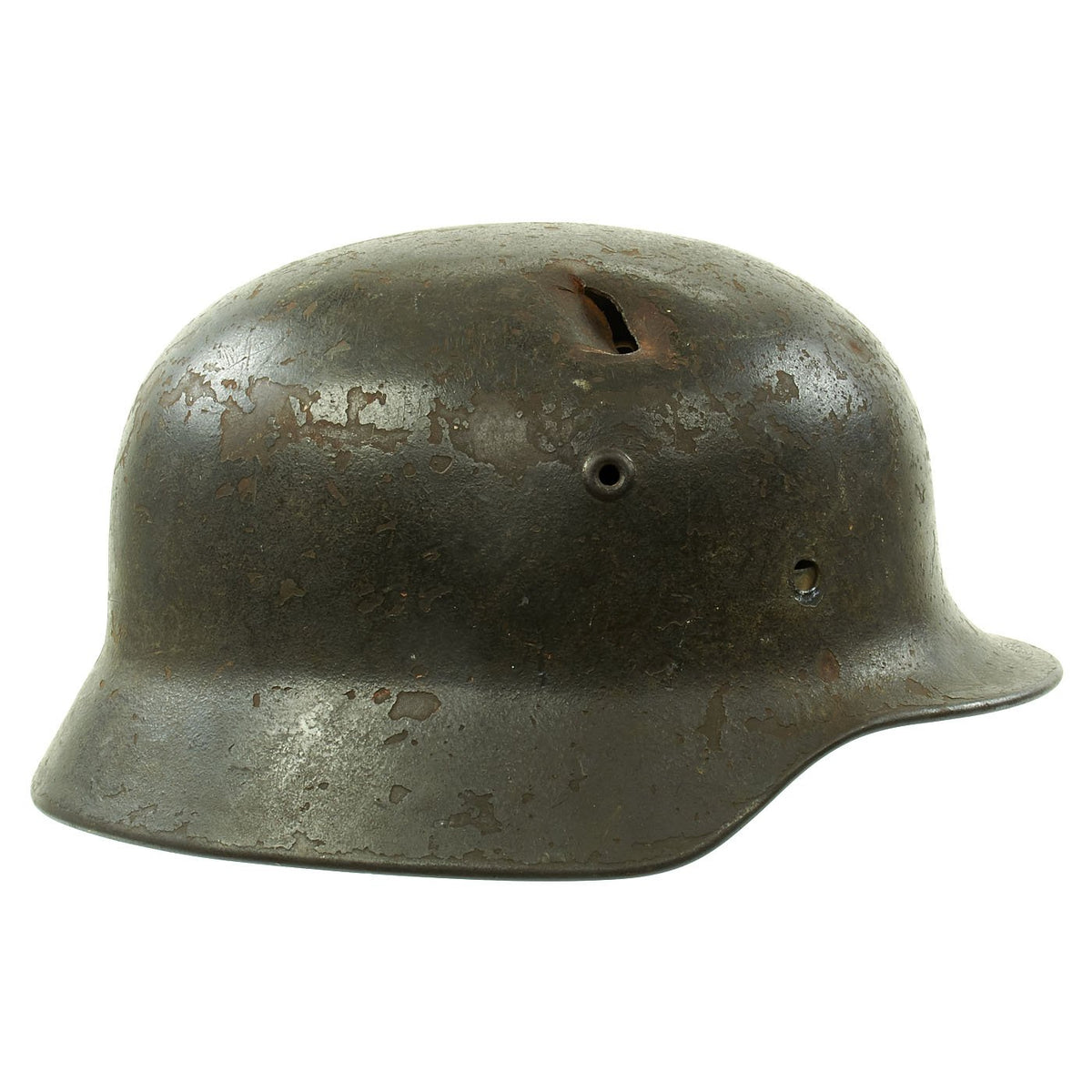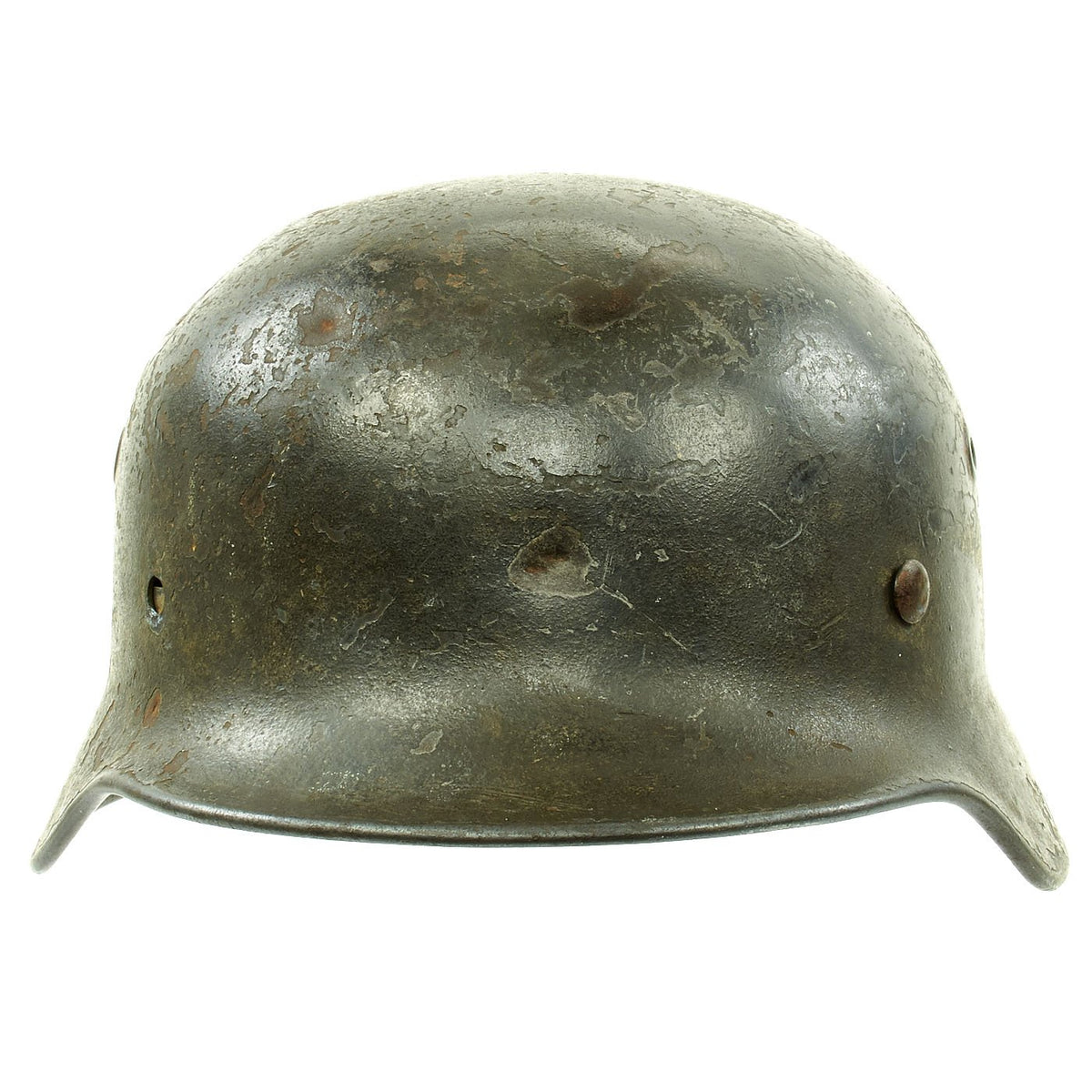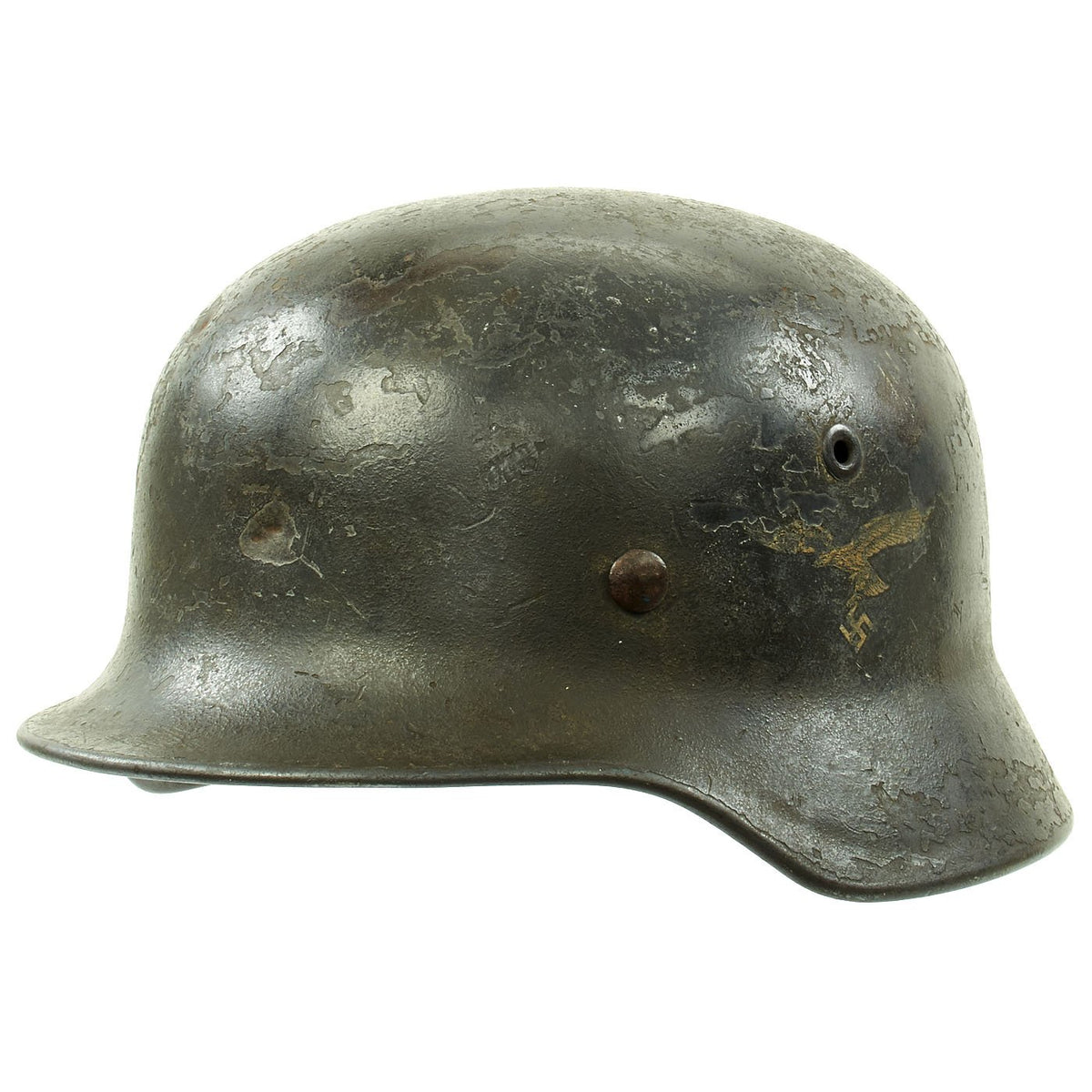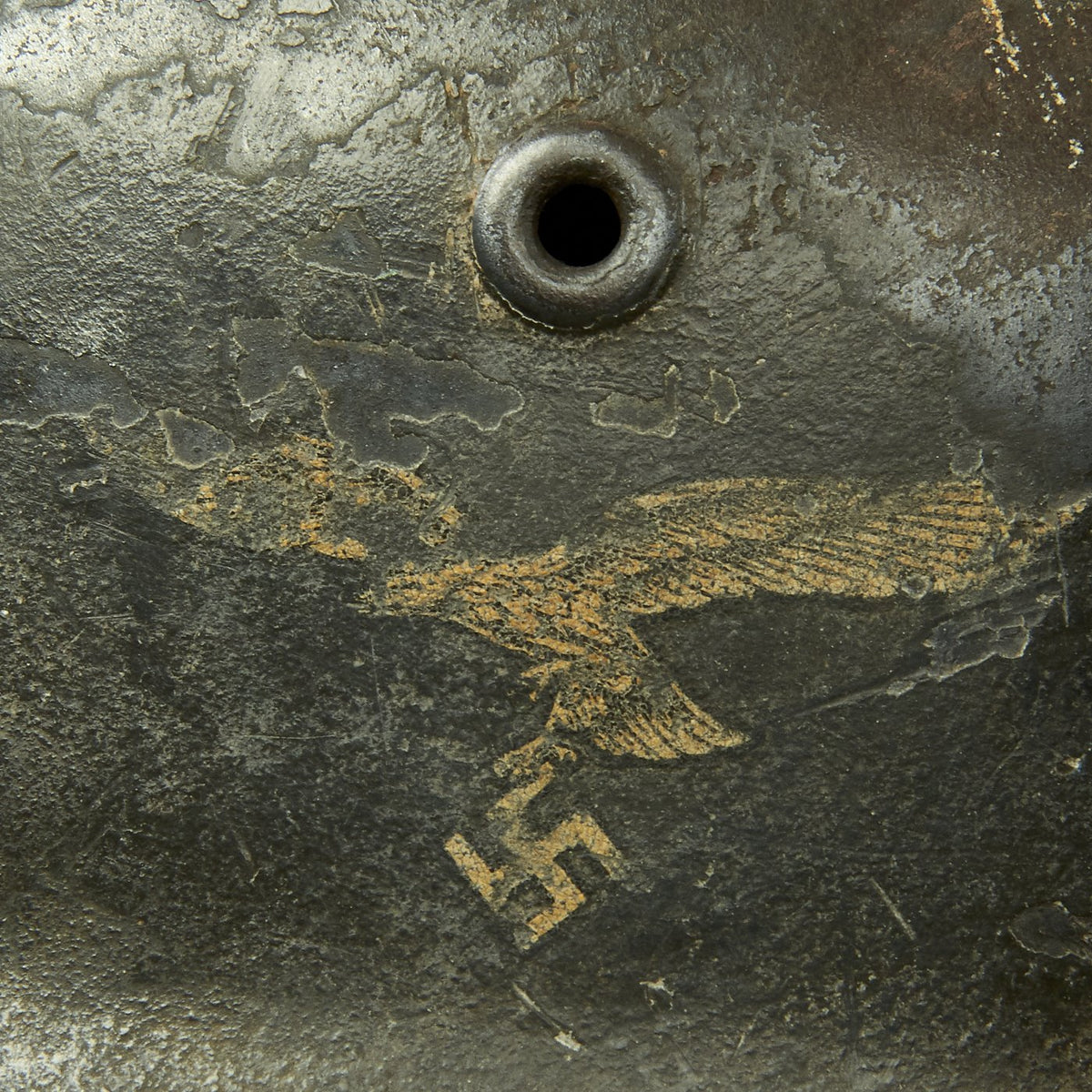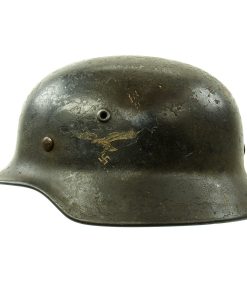Original German WWII M40 Battle Damaged Single Decal Luftwaffe Helmet with 60cm Liner – Q68 Original Items
$ 995,00 $ 248,75
Original Item: Only One Available. This is a very nice all original example Model 1940 German WWII helmet with a single Luftwaffe Eagle decal, and some very interesting battle damage on the upper right side. This consists of what may be a bullet or shrapnel strike above the vent hole. It is also possible it was from a blow sustained from a weapon or other falling object. In addition to the hole, the blow caused the liner band to exert enough pressure to shear off the nearby split pin. There are also bends to the liner band that may indicate it was pulled away very hard by the chin strap. There is also a small dent inward on the helmet front. Definitely worth some further research!
This stamped sheet steel construction helmet retains about 60% of the original Luftwaffe Blue-Gray paint, and shows quite a bit of wear throughout. There are many areas where the paint is worn through, showing the stamped steel body. This was definitely a helmet that saw significant use during the war, with a great patina of age. The decal is retained at around 60%, and shows a lot of overall fading and discoloration. If you were looking for a nice “battle worn” helmet for your collection, this is it!
The reverse, interior, neck guard apron is serial number stamped 165 and the interior, left side, apron has the stamped manufacturer’s code and size, Q68 indicating that it was manufactured by Quist in the German city of Esslingen. Size 68 is a rare extra large size that can accommodate liners from 60cm to 61cm or US 7 1/2 to 7 5/8. Size 68 shells are the hardest to find and are therefore more valuable to a collector.
Two of the three liner retaining split pins are still intact, but have most of the original paint on the ends. The interior of the helmet still has an original good M31 leather liner with all eight fingers, with the original securing string. The leather is somewhat soft, with some splitting and degradation around the rim. The side of the galvanized steel liner band is marked 68 n.A. / 60, indicating that this is a size 60 liner for a size 68 shell. The other side has the manufacturer and date, though only D.R.P. / 1940 is clear. The original chin strap is completely missing, most likely removed to use on another helmet.
Overall a nice condition genuine Battle Damaged M40 Single Decal Luftwaffe helmet! This is an item that will only continue to appreciate in value over time.
The first “modern” steel helmets were introduced by the French army in early 1915 and were shortly followed by the British army later that year. With plans on the drawing board, experimental helmets in the field, (“Gaede” helmet), and some captured French and British helmets the German army began tests for their own steel helmet at the Kummersdorf Proving Grounds in November, and in the field in December 1915. An acceptable pattern was developed and approved and production began at Eisen-und Hüttenwerke, AG Thale/Harz, (Iron and Foundry Works), in the spring of 1916.
These first modern M16 helmets evolved into the M18 helmets by the end of WWI. The M16 and M18 helmets remained in usage through-out the Weimar Reichswehr, (National Defence Force, Circa 1919-1933), era and on into the early years of the Third Reich until the development of the smaller, lighter M35 style helmet in June 1935.
In 1934 tests began on an improved Stahlhelm, whose design was a development of World War I models. The Eisenhüttenwerke company of Thale carried out prototype design and testing, with Dr. Friedrich Schwerd once again taking a hand.
The new helmet was pressed from sheets of molybdenum steel in several stages. The size of the flared visor and skirt was reduced, and the large projecting lugs for the obsolete armor shield were eliminated. The ventilator holes were retained, but were set in smaller hollow rivets mounted to the helmet’s shell. The edges of the shell were rolled over, creating a smooth edge along the helmet. Finally, a completely new leather suspension, or liner, was incorporated that greatly improved the helmet’s safety, adjustability, and comfort for each wearer. These improvements made the new M1935 helmet lighter, more compact, and more comfortable to wear than the previous designs.
The Army’s Supreme Command officially accepted the new helmet on June 25, 1935 and it was intended to replace all other helmets in service.
The M1935 design was slightly modified in 1940 to simplify its construction, the manufacturing process now incorporating more automated stamping methods. The principal change was to stamp the ventilator hole mounts directly onto the shell, rather than utilizing separate fittings. In other respects, the M1940 helmet was identical to the M1935. The Germans still referred to the M1940 as the M1935, while the M1940 designation were given by collectors.
The last wartime upgrade to the standard helmet took place on 6 July 1942 at the request of the Army High Command. The rolled edge found on M1935 and M1940 helmets was discontinued as a measure of economy. On 1 August 1942 the first M1942 helmets were placed into production, and this was the model produced until late in the war, when most factories were captured or stood idle due to material shortages.
Fast Shipping with Professional Packaging
Thanks to our longstanding association with UPS FedEx DHL, and other major international carriers, we are able to provide a range of shipping options. Our warehouse staff is expertly trained and will wrap your products according to our exact and precise specifications. Prior to shipping, your goods will be thoroughly examined and securely secured. We ship to thousands clients each day across multiple countries. This shows how we're dedicated to be the largest retailer on the internet. Warehouses and distribution centres can be located throughout Europe as well as the USA.
Note: Orders with more than one item will be assigned a processing date depending on the item.
Before shipping before shipping, we'll conduct a thorough inspection of the items you have ordered. Today, the majority of orders will be delivered within 48 hours. The delivery time will be between 3-7 days.
Returns
The stock is dynamic and we cannot completely manage it because multiple stakeholders are involved, including our factory and warehouse. So the actual stock may alter at any time. It's possible that you may not receive your order once the order has been made.
Our policy is valid for a period of 30 days. If you don't receive the product within 30 days, we are not able to issue a refund or an exchange.
You can only return an item if it is unused and in the same state as the day you received it. You must have the item in its original packaging.
Related products
Uncategorized
Uncategorized
Uncategorized
Uncategorized
Uncategorized
Uncategorized
Uncategorized
Uncategorized
Angolan Rebel 1970s era 60mm Inert Display Mortar from Angolan Civil War Original Items
Uncategorized
Uncategorized
Uncategorized
Australian WWII Owen MK1 Machine Carbine SMG Custom Fabricated Replica with Sling Original Items
Uncategorized
Uncategorized
Uncategorized
Uncategorized
Uncategorized
Uncategorized
Uncategorized
